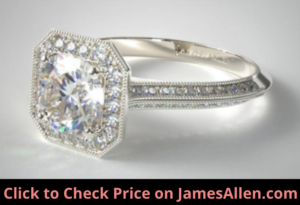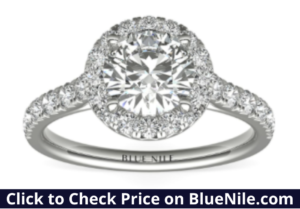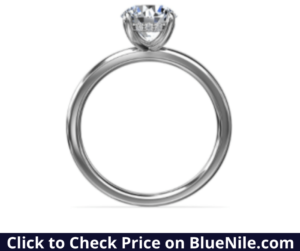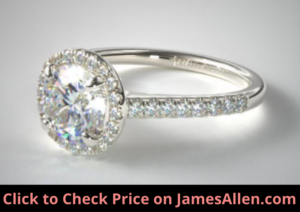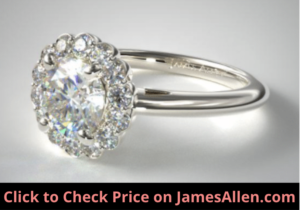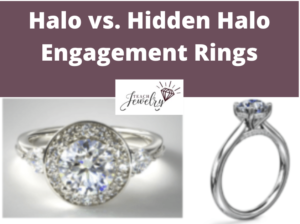
There are many customizations for diamond ring settings.
Halos and hidden halos are two types of settings that feature a small ring of diamonds.
The main difference between halo and hidden halo settings is halos are visible from the top-down view because they’re positioned close to the same height as the center diamond. Hidden halos have a smaller diameter than the diamond and are placed below its crown.
We’ll compare halo versus hidden halo engagement ring settings, including an overview of each, how they’re different, similarities, and how to decide which is right for you.
What is a Halo Setting?
Halo settings include a circle of diamonds around the main one. The extra gems make the diamond appear larger because they blend together.
Check out this example, where more than 20 diamonds are placed in an octagonal shape around the center diamond.
The pave or micro pave diamonds are positioned against the center diamond or leave a gap between them. The gap design is called a floating halo because the ring of diamonds appears to float above the setting.
If it’s at the same level as the main stone, it’s a flush halo.
Halo settings are one of the most versatile styles for engagement rings. There are more than 10 types of halos, ranging from hexagonal and octagonal halos to floral and gemstone designs.
For example, take a look at this halo engagement ring from James Allen. Instead of the traditional rounded aesthetic, it has four straight edges.
The halo is formed by 14 pave diamonds, and another 74 line the shank.
As a contrast, this French pave halo setting has a rounded design.
It’s set below the main diamond but still creates the illusion of a larger one.
If you’re considering a halo setting for your engagement ring, there are endless variations to explore that each complement the diamond in their own way.
What is a Hidden Halo Setting?
Hidden halos earn their name because the feature is invisible from the top-down view.
It’s a belt of diamonds that wraps around the top of the setting, usually tucked under the diamond’s crown.
To illustrate, this ring includes 13 accents that form a hidden halo.
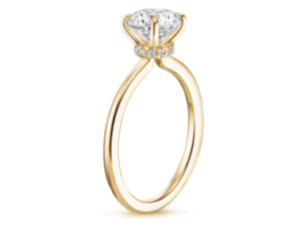
It sits below the culet. If your rotate the image so the diamond faces toward, the halo disappears from view.
One distinct attribute of hidden halos is the diamonds face sideways. If you view it from the profile, their tables face toward you.
This enhances the brilliance of the piece from this angle.
Hidden halos aren’t unique to round cuts. They pair with every type of diamond. The setting above can be set with 10 cuts, including:
- Cushion
- Oval
- Emerald
- Pear
Some buyers opt for this style when the center diamond is step-cut that doesn’t have strong light performance.
If you’ve chosen an emerald or Asscher cut, your diamond ring could appear dull compared to a brilliant cut and instead radiate a soft glow.
But hidden halos help compensate by including brilliant-cut diamonds on the setting.
What are the Differences Between Halos and Hidden Halos?
1. Hidden Halos Require a High Setting
Hidden halos often require a higher setting because the accents need room to sit under the main diamond.
Like their names suggest, the diamond on a high setting sits far above the ring, while a low setting sits closer.
In general, a high setting results in improved light performance but leaves the diamond more vulnerable to hits and bumps. A low setting offers protection because it lays close to your finger.
The exact height of the setting and position of the hidden halo depend on the design.
This solitaire setting includes a hidden halo around the diamond’s culet, but the setting isn’t much higher than normal.
As a contrast, this piece has a hidden halo below the culet.
The entire diamond sits above the wrap, so the setting is high.
Most buyers who select a high setting also choose a large diamond. In its prominent position, you don’t want it to appear small.
With a small center diamond, it’s common to place it on a low setting and complement it with accents like a halo or pave diamonds.
2. Halos Can Distract from the Main Diamond
One reason to choose a hidden halo instead of a traditional one is because a halo can distract from the main diamond. As the most important part of the ring, some buyers want it to stand alone.
A halo setting crowds it with several small diamonds that often don’t have the same brilliance. In fact, part of the appeal of a halo setting is it can imitate a single, larger diamond.
This a benefit if the center diamond is small but isn’t always the best choice for heavy diamonds.
Take this setting from James Allen as an example.
The halo’s design is intended to blend the diamond and accents together. In the high-resolution image, it’s obvious there’s a halo.
But if you saw someone wearing the ring, it wouldn’t be as noticeable.
If you want all the attention on the main diamond, we wouldn’t recommend this type of halo setting.
On the other hand, the halo on this setting is more distinct from the diamond. There’s a thicker ring around the accents, so they sit deeper behind the diamond.
It still covers the sides of the diamond, so it’s not visible from every angle.
But the halo and diamond are more distinguishable, even from a distance.
3. Hidden Halos Allow You to Mix Metals
The most common types of metals for engagement rings are yellow, white, and rose gold and platinum. Within those three types of gold, jewelry retailers often offer 14K or 18K gold.
Hidden halos allow you to choose more than one metal.
One type is used for the shank, and the other holds the hidden halo diamonds.
For example, this mixed metal diamond engagement ring includes a 14K rose gold belt on the 18K white gold band.
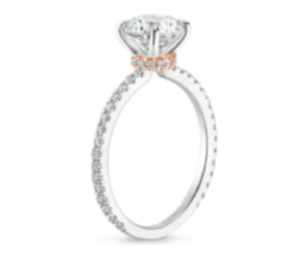
From the top-down view, the rose gold won’t be visible, but it adds a unique element when viewed from the side.
The mixed metals are available in a variety of combinations.
If you’re looking for ways to make your ring stand out from a classic solitaire design or from one with a uniform color, a hidden halo with multiple types of metals could be the right fit.
It should be noted this design is also available on some halo settings.
4. Halo Settings are More Popular
Solitaire settings are the most common choice for diamond rings, but halo settings are second in line.
One reason halo settings are more popular than hidden halos is because the accents increase the apparent size of the piece in a more noticeable way.
It’s also without the price premium that results from a heavier center diamond when compared to a solitaire setting.
Let’s use an example to illustrate.
We compiled prices for more than 30 diamonds from James Allen that had the following grades:
- Color: F
- Cut: Very good
- Clarity: VVS2
Ones that weighed 0.80 carats were priced at an average of $4,448, with a range of $4,020-$5,060.
For 1.01-carat diamonds with those grades, the average price was $9,604, and the range was $7,120-$11,470.
That’s a 116 percent increase, or $5,156, for the extra 0.21 carats.
Now let’s take this 14K white gold halo setting.
The accents have a total carat weight of 0.21.
It costs $1,390.
You’d pay a total of $5,838 for the halo diamond ring, and more than $10,000 for the solitaire.
A solitaire setting with the 1.01-carat diamond is far more expensive than the halo setting with the same total carat weight.
So if you want an alternative to a solitaire setting that’s still a popular choice, you can opt for a halo setting.
But for a style only seen on a small percentage of rings, consider a hidden halo.
How to Decide Between a Halo and Hidden Halo
If you’re deciding between a halo versus a hidden halo setting for your diamond ring, you should understand how those customizations affect its appearance and performance.
Here are some tips to help you decide.
Choose a halo setting if:
- It’s important the accents are visible from the top-down view
- You want to avoid the price premium of increasing the carat weight of the center diamond, but you want a higher total carat weight for your ring
- You’re interested in selecting from the different types of halos, like floral or star-shaped designs
Opt for a hidden halo if:
- You want to increase the apparent size of the diamond, without a halo that’s always visible
- Mixing two metals to create your ring is appealing to you
- You’ve decided on a high setting and want to place additional diamonds on the ring
- It’s a step-cut diamond that doesn’t exhibit as much brilliance, and you want to improve its light performance without a halo apparent from every angle
By pairing diamonds with halo and hidden halo settings, you’ll create the perfect ring for you.

Jacob Clarke
Jacob Clarke is the founder of TeachJewelry.com.
He earned an Applied Jewelry Professional Diploma from the Gemological Institute of America (GIA) and now brings you essential information about diamonds, settings, and more.
Jacob has consulted with leading jewelry brands, and his work has been cited in Clean Origin, Diamond Nexus and industry publications.
He's also a member of the International Gem Society.
He enjoys discussing jewelry with readers, so contact him with any questions at jacob.clarke@teachjewelry.com.

